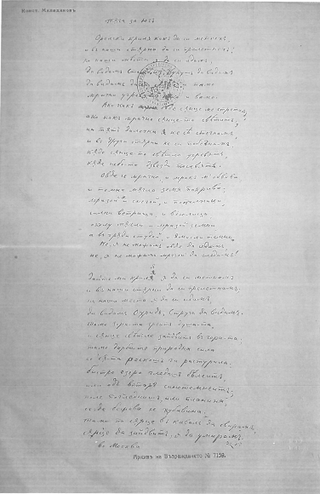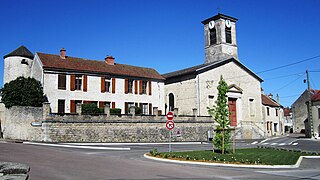
Lieutenant General Alexander Ivanovich Lebed was a Soviet and Russian military officer and politician who held senior positions in the Airborne Troops before running for president in the 1996 Russian presidential election. He did not win, but placed third behind incumbent Boris Yeltsin and the Communist Party leader Gennady Zyuganov, with roughly 14% of the vote nation-wide. Lebed later served as the Secretary of the Security Council in the Yeltsin administration, and eventually became the governor of Krasnoyarsk Krai, the second largest Russian region. He served four years in the latter position, until his death following a Mi-8 helicopter crash.

The lèbes gamikòs or "nuptial lebes" is a form of ancient Greek pottery used in marriage ceremonies. It was probably used in the ritual sprinkling of the bride with water before the wedding. In form, it has a large bowl-like body and a stand that can be long or short. Painted scenes are placed on either the body of the vessel or the stand.

Dzhebel or Djebel is a town in Kardzhali Province, southern Bulgaria. It has 3,312 inhabitants. Dzhebel is the administrative center of a municipality, which apart from Dzhebel itself, contains 47 other villages and has a population of 9,093. The municipality is mainly populated by ethnic Turks, which are more than 75% of the total population. The word Dzhebel derives from the Arabic word "جبل (jabal)" which means "mountain".

Taga za Yug was a poem by the Bulgarian National Revival poet Konstantin Miladinov. It is a patriotic-reflexive song in which the author, who lives in Moscow, expresses his homesickness for his homeland. By the end of the 1850s, Bulgarian poets as Miladinov started to write lyric poetry in vernacular. This poem was written in the Struga dialect.
Lebed means swan is several Slavic languages and may refer to:

The Albatros B.I, was a German military reconnaissance aircraft designed in 1913 and which saw service during World War I.

Ustra is a medieval fortress in the eastern Rhodope Mountains in southern Bulgaria. It is among the highest and best preserved fortifications in the mountain range. The fortress was controlled by the Byzantine and the Bulgarian Empires until the region was conquered by the Ottoman Turks in the second half of the 14th century.

Mykola Kyrylovych Lebed was a Ukrainian nationalist political activist and guerrilla fighter. He was among those tried, convicted, and imprisoned for the murder of Polish interior minister Bronisław Pieracki in 1934. The court sentenced him to death, but the state commuted the sentence to life imprisonment. He escaped when the Germans invaded Poland in 1939. As a leader of OUN-B, he was responsible for the massacres of Poles in Volhynia and Eastern Galicia.

Sainte-Colombe-sur-Seine is a commune in the Côte-d'Or department in eastern France.

The LVG B.I was a 1910s German two-seat reconnaissance biplane designed by Luft-Verkehrs-Gesellschaft for the Luftstreitkräfte.

Balkantourist is the oldest existing Bulgarian tour operator, established on 6 January 1948 as a state-owned government monopoly in what was then the People's Republic of Bulgaria. Privatised in 1995, it has continued to exist in the post-1989 conditions of market economy.

The Kalmar class are a class of medium-sized assault hovercraft designed for the Soviet Navy. The few remaining craft are operated by the Russian Navy.
Sangha is a rural commune in the Cercle of Bandigara in the Mopti Region of Mali. The commune contains around 44 small villages and in the 2009 census had a population of 32,513. The administrative centre (chef-lieu) is the village of Sangha Ogol Leye, one of a cluster of at least 10 small villages at the top of the Bandiagara Escarpment.

A hogon is a spiritual leader in a Dogon village who plays an important role in Dogon religion.

Ich lebe, mein Herze, zu deinem Ergötzen, BWV 145, is a five-movement church cantata on a libretto by Picander which Johann Sebastian Bach, as its composer, probably first performed in Leipzig on Easter Tuesday, 19 April 1729. As a seven-movement pasticcio, with one of the added movements composed by Georg Philipp Telemann, it is an Easter cantata known as So du mit deinem Munde bekennest Jesum or as Auf, mein Herz!.

Dobrodan Glacier is the 3.4 km long and 1.2 km wide glacier on the east side of Urda Ridge on Clarence Island in the South Shetland Islands, Antarctica situated south of Highton Glacier. It drains the slopes of Mount Irving and Duclos-Guyot Bluff, flows northeastwards and enters the Southern Ocean south of Lebed Point.

Lebed Point is the rocky point on the south side of the entrance to Istros Bay on the east coast of Clarence Island in the South Shetland Islands, Antarctica.

Istros Bay is the 3.2 km wide bay indenting for 1.4 km the east coast of Clarence Island in the South Shetland Islands, Antarctica. It is entered north of Lebed Point and south of Sugarloaf Island, and has its head fed by Highton Glacier. Istros is the ancient name for the lower Danube River.
Swan is a 1976 Bulgarian drama film, directed by Rumen Surdzhiyski. Screenplay writer is Vladimir Ganev. Based on the story "Stubborn people" from the collection "Devil's tails" (1972), by the writer Ivailo Petrov. Cinematographer is Lachezar Videnov. Production designer is Anastas Yanakiev. The music of the film is composed by Bozhidar Petkov. Parts of the film were shot in Bankya, Sozopol, Sunny Beach and the cove of Alepù, at cape "Malkata Agalina".
The Lebe or Lewe is a Dogon religious, secret institution and primordial ancestor, who arose from a serpent. According to Dogon cosmogony, Lebe is the reincarnation of the first Dogon ancestor who, resurrected in the form of a snake, guided the Dogons from the Mandé to the cliff of Bandiagara where they are found today.















